Zonation of a Viticultural Territorial Context in Piemonte (NW Italy) to Support Terroir Identification: The Role of Pedological, Topographical and Climatic Factors
Abstract
1. Introduction
2. Materials and Methods
2.1. Study Area
2.2. Available Data
2.3. Data Processing
3. Results and Discussion
3.1. Analyzing Spatial Distribution of Grape Varieties
3.2. Data Pre-Processing
3.3. K-Means Clustering and Zonal Statistics Computation
3.4. Analyzing Grape Variety Dependence from Zones
4. Conclusions
Author Contributions
Funding
Institutional Review Board Statement
Informed Consent Statement
Data Availability Statement
Conflicts of Interest
References
- Vrignon-Brenas, S.; Metay, A.; Leporatti, R.; Gharibi, S.; Fraga, A.; Dauzat, M.; Rolland, G.; Pellegrino, A. Gradual Responses of Grapevine Yield Components and Carbon Status to Nitrogen Supply. OENO One 2019, 53, 289–306. [Google Scholar] [CrossRef]
- Duchêne, E.; Schneider, C.; Gaudillere, J.P. Effects of Nitrogen Nutrition Timing on Fruit Set of Grapevine, Cv. Grenache. Vitis-Geilweilerhof 2001, 40, 45–46. [Google Scholar]
- Verdenal, T.; Dienes-Nagy, Á.; Spangenberg, J.E.; Zufferey, V.; Spring, J.-L.; Viret, O.; Marin-Carbonne, J.; van Leeuwen, C. Understanding and Managing Nitrogen Nutrition in Grapevine: A Review. OENO One 2021, 55, 3866. [Google Scholar] [CrossRef]
- Cardoso, A.S.; Alonso, J.; Rodrigues, A.S.; Araújo-Paredes, C.; Mendes, S.; Valín, M.I. Agro-Ecological Terroir Units in the North West Iberian Peninsula Wine Regions. Appl. Geogr. 2019, 107, 51–62. [Google Scholar] [CrossRef]
- Vaudour, E.; Leclercq, L.; Gilliot, J.-M.; Chaignon, B. Retrospective 70 Y-Spatial Analysis of Repeated Vine Mortality Patterns Using Ancient Aerial Time Series, Pléiades Images and Multi-Source Spatial and Field Data. Int. J. Appl. Earth Obs. Geoinf. 2017, 58, 234–248. [Google Scholar] [CrossRef]
- Sarvia, F.; Petris, S.D.; Borgogno-Mondino, E. A Methodological Proposal to Support Estimation of Damages from Hailstorms Based on Copernicus Sentinel 2 Data Times Series. In Proceedings of the International Conference on Computational Science and Its Applications, Cagliari, Italy, 1–4 July 2020; Springer: Berlin/Heidelberg, Germany; pp. 737–751. [Google Scholar]
- Sarvia, F.; De Petris, S.; Borgogno-Mondino, E. Mapping Ecological Focus Areas within the EU CAP Controls Framework by Copernicus Sentinel-2 Data. Agronomy 2022, 12, 406. [Google Scholar] [CrossRef]
- Sarvia, F.; De Petris, S.; Borgogno-Mondino, E. Remotely Sensed Data to Support Insurance Strategies in Agriculture. In Proceedings of the Remote Sensing for Agriculture, Ecosystems, and Hydrology XXI, Strasbourg, France, 9–11 September 2019; SPIE: Bellingham, WA, USA, 2019; Volume 11149, pp. 438–448. [Google Scholar]
- De Petris, S.; Sarvia, F.; Borgogno-Mondino, E. RPAS-Based Photogrammetry to Support Tree Stability Assessment: Longing for Precision Arboriculture. Urban For. Urban Green. 2020, 55, 126862. [Google Scholar] [CrossRef]
- González, P.A.; Dans, E.P. The’terroirist’social Movement: The Reawakening of Wine Culture in Spain. J. Rural. Stud. 2018, 61, 184–196. [Google Scholar] [CrossRef]
- Van Leeuwen, C.; Seguin, G. The Concept of Terroir in Viticulture. J. Wine Res. 2006, 17, 1–10. [Google Scholar] [CrossRef]
- Van Leeuwen, C.; Roby, J.P.; De Resseguier, L. Soil-Related Terroir Factors: A Review. OENO One 2018, 52, 173–188. [Google Scholar] [CrossRef]
- Priori, S.; Barbetti, R.; L’Abate, G.; Bucelli, P.; Storchi, P.; Costantini, E.A. Natural Terroir Units, Siena Province, Tuscany. J. Maps 2014, 10, 466–477. [Google Scholar] [CrossRef]
- Sánchez, Y.; Martínez-Graña, A.M.; Santos-Francés, F.; Yenes, M. Index for the Calculation of Future Wine Areas According to Climate Change Application to the Protected Designation of Origin “Sierra de Salamanca” (Spain). Ecol. Indic. 2019, 107, 105646. [Google Scholar] [CrossRef]
- Honorio, F.; García-Martín, A.; Moral, F.J.; Paniagua, L.L.; Rebollo, F.J. Spanish Vineyard Classification According to Bioclimatic Indexes. Aust. J. Grape Wine Res. 2018, 24, 335–344. [Google Scholar] [CrossRef]
- Karoglan, M.; Prtenjak, M.T.; Šimon, S.; Osrečak, M.; Anić, M.; Kontić, J.K.; Andabaka, Ž.; Tomaz, I.; Grisogono, B.; Belušić, A. Classification of Croatian Winegrowing Regions Based on Bioclimatic Indices. In Proceedings of the E3S Web of Conferences, Moscow, Russia, 3–5 December 2018; EDP Sciences: Les Ulis, France, 2018; Volume 50, p. 01032. [Google Scholar]
- Rieutort, L. Terroir. Hypergeo 2012, 1–2. Available online: http://geopuc.geo.puc-rio.br/media/v12n22a3-%20SARANTAKOS%20D.pdf (accessed on 27 October 2022).
- Demossier, M. Beyond Terroir: Territorial Construction, Hegemonic Discourses, and French Wine Culture. J. R. Anthropol. Inst. 2011, 17, 685–705. [Google Scholar] [CrossRef]
- Vaudour, E.; Carey, V.A.; Gilliot, J.-M. Digital Zoning of South African Viticultural Terroirs Using Bootstrapped Decision Trees on Morphometric Data and Multitemporal SPOT Images. Remote Sens. Environ. 2010, 114, 2940–2950. [Google Scholar] [CrossRef]
- Martínez, A.; Gomez-Miguel, V.D. Vegetation Index Cartography as a Methodology Complement to the Terroir Zoning for Its Use in Precision Viticulture. OENO One 2017, 51, 289. [Google Scholar] [CrossRef]
- Moral, F.J.; Rebollo, F.J.; Paniagua, L.L.; García-Martín, A. A GIS-Based Multivariate Clustering for Characterization and Ecoregion Mapping from a Viticultural Perspective. Span. J. Agric. Res. 2016, 14, e0206. [Google Scholar] [CrossRef]
- Madruga, J.; Azevedo, E.B.; Sampaio, J.F.; Fernandes, F.; Reis, F.; Pinheiro, J. Analysis and Definition of Potential New Areas for Viticulture in the Azores (Portugal). Soil 2015, 1, 515–526. [Google Scholar] [CrossRef]
- Irimia, L.M.; Patriche, C.V.; Quénol, H. Analysis of Viticultural Potential and Delineation of Homogeneous Viticultural Zones in a Temperate Climate Region of Romania. OENO One 2014, 48, 145–167. [Google Scholar] [CrossRef]
- Bramley, R.G.V.; Gardiner, P.S. Underpinning Terroir with Data: A Quantitative Analysis of Biophysical Variation in the Margaret River Region of Western Australia. Aust. J. Grape Wine Res. 2021, 27, 420–430. [Google Scholar] [CrossRef]
- Bramley, R.G.; Ouzman, J.; Trought, M.C. Making Sense of a Sense of Place: Precision Viticulture Approaches to the Analysis of Terroir at Different Scales: This Article Is Published in Cooperation with the XIIIth International Terroir Congress November 17–18 2020, Adelaide, Australia. Guest Editors: Cassandra Collins and Roberta De Bei. OENO One 2020, 54, 903–917. [Google Scholar]
- Sanga-Ngoie, K.; Kumara, K.J.C.; Kobayashi, S. Potential Grape–Growing Sites in the Tropics: Exploration and Zoning Using a Gis Multi-Criteria Evaluation Approach. Proc. Asian Assoc. Remote Sens. 2010, 6. [Google Scholar]
- Bramley, R.G.V.; Ouzman, J. Underpinning Terroir with Data: On What Grounds Might Subregionalisation of the Barossa Zone Geographical Indication Be Justified? Aust. J. Grape Wine Res. 2022, 28, 196–207. [Google Scholar] [CrossRef]
- Failla, O.; Mariani, L.; Brancadoro, L.; Minelli, R.; Scienza, A.; Murada, G.; Mancini, S. Spatial Distribution of Solar Radiation and Its Effects on Vine Phenology and Grape Ripening in an Alpine Environment. Am. J. Enol. Vitic. 2004, 55, 128–138. [Google Scholar] [CrossRef]
- Fraga, H.; Costa, R.; Santos, J. Modelling the Terroir of the Douro Demarcated Region, Portugal. In Proceedings of the E3S Web of Conferences, Moscow, Russia, 3–5 December 2018; EDP Sciences: Les Ulis, France, 2018; Volume 50, p. 02009. [Google Scholar]
- Priori, S.; Valboa, G.; Pellegrini, S.; Perria, R.; Puccioni, S.; Storchi, P.; Costantini, E.A. Scale Effect of Viticultural Zoning under Three Contrasting Vintages in Chianti Classico Area (Tuscany, Italy). In Proceedings of the E3S Web of Conferences, Moscow, Russia, 3–5 December 2018; EDP Sciences: Les Ulis, France, 2018; Volume 50, p. 02012. [Google Scholar]
- Mackenzie, D.E.; Christy, A.G. The Role of Soil Chemistry in Wine Grape Quality and Sustainable Soil Management in Vineyards. Water Sci. Technol. 2005, 51, 27–37. [Google Scholar] [CrossRef] [PubMed]
- Protano, G.; Rossi, S. Relationship between Soil Geochemistry and Grape Composition in Tuscany (Italy). J. Plant Nutr. Soil Sci. 2014, 177, 500–508. [Google Scholar] [CrossRef]
- White, R.E. The Value of Soil Knowledge in Understanding Wine Terroir. Front. Environ. Sci. 2020, 8, 12. [Google Scholar] [CrossRef]
- Reynolds, A.G.; Rezaei, J.H. Spatial Variability in Ontario Cabernet Franc Vineyards: I. Interrelationships among Soil Composition, Soil Texture, Soil and Vine Water Status. J. Appl. Hortic. 2014, 16, 3–23. [Google Scholar] [CrossRef]
- Marciniak, M.; Reynolds, A.G.; Brown, R.; Jollineau, M.; Kotsaki, E. Applications of Geospatial Technologies to Understand Terroir Effects in an Ontario Riesling Vineyard. Am. J. Enol. Vitic. 2017, 68, 169–187. [Google Scholar] [CrossRef]
- Morari, F.; Castrignanò, A.; Pagliarin, C. Application of Multivariate Geostatistics in Delineating Management Zones within a Gravelly Vineyard Using Geo-Electrical Sensors. Comput. Electron. Agric. 2009, 68, 97–107. [Google Scholar] [CrossRef]
- Noble, A.C. Evaluation of Chardonnay Wines Obtained from Sites with Different Soil Compositions. Am. J. Enol. Vitic. 1979, 30, 214–217. [Google Scholar] [CrossRef]
- Bramley, R.G.V.; Ouzman, J.; Boss, P.K. Variation in Vine Vigour, Grape Yield and Vineyard Soils and Topography as Indicators of Variation in the Chemical Composition of Grapes, Wine and Wine Sensory Attributes. Aust. J. Grape Wine Res. 2011, 17, 217–229. [Google Scholar] [CrossRef]
- Jones, G. Climate and Terroir: Impacts of Climate Variability and Change on Wine. Geosci. Can. Repr. Ser. 2006, 9, 203–217. [Google Scholar]
- Santos, J.A.; Fraga, H.; Malheiro, A.C.; Moutinho-Pereira, J.; Dinis, L.-T.; Correia, C.; Moriondo, M.; Leolini, L.; Dibari, C.; Costafreda-Aumedes, S.; et al. A Review of the Potential Climate Change Impacts and Adaptation Options for European Viticulture. Appl. Sci. 2020, 10, 3092. [Google Scholar] [CrossRef]
- Jones, G.V. The Climate Component of Terroir. Elem. Int. Mag. Mineral. Geochem. Petrol. 2018, 14, 167–172. [Google Scholar] [CrossRef]
- Jones, G.V.; White, M.A.; Cooper, O.R.; Storchmann, K. Climate Change and Global Wine Quality. Clim. Change 2005, 73, 319–343. [Google Scholar] [CrossRef]
- Van Leeuwen, C.; Darriet, P. The Impact of Climate Change on Viticulture and Wine Quality. J. Wine Econ. 2016, 11, 150–167. [Google Scholar] [CrossRef]
- Jurisic, M.; Stanisavljevic, A.; Plascak, I. Application of Geographic Information System (GIS) in the Selection of Vineyard Sites in Croatia. Bulg. J. Agric. Sci. 2010, 16, 235–242. [Google Scholar]
- Hunter, J.J.; Volschenk, C.G.; Booyse, M. Vineyard Row Orientation and Grape Ripeness Level Effects on Vegetative and Reproductive Growth Characteristics of Vitis Vinifera L. Cv. Shiraz/101-14 Mgt. Eur. J. Agron. 2017, 84, 47–57. [Google Scholar] [CrossRef]
- Strack, T.; Stoll, M. Implication of Row Orientation Changes on Fruit Parameters of Vitis Vinifera L. Cv. Riesling in Steep Slope Vineyards. Foods 2021, 10, 2682. [Google Scholar] [CrossRef]
- Salata, S.; Ozkavaf-Senalp, S.; Velibeyoğlu, K.; Elburz, Z. Land Suitability Analysis for Vineyard Cultivation in the Izmir Metropolitan Area. Land 2022, 11, 416. [Google Scholar] [CrossRef]
- ISTAT—Istituto Nazionale Di Statistica. Available online: https://www.istat.it/it/ (accessed on 27 October 2022).
- ISMEA Mercati. Available online: https://www.ismeamercati.it/vino (accessed on 27 October 2022).
- WineNews—The Pocket Wine Web Site in Italy. Available online: Https://winenews.it/it/ (accessed on 27 October 2022).
- Vini Piemontesi—Storia, Vitigni, DOC, DOCG, Vini Famosi—Italy’s Finest Wines. Available online: https://italysfinestwines.it/vini-piemontesi/ (accessed on 27 October 2022).
- RETEVINO DOP-IGP—Ismea Mercati. Available online: https://www.ismeamercati.it/retevino-dop-igp (accessed on 27 October 2022).
- ASSOVINI—Associazione Nazionale Produttori Vinicoli e Turismo Del Vino. Available online: https://www.assovini.it/ (accessed on 27 October 2022).
- CHM—Community Heritage Maps. Available online: https://www.communityheritagemaps.com/ (accessed on 27 October 2022).
- Vineyards—The Vineyard Explorer—Piedmont Wine Map. Available online: https://vineyards.com/wine-map/italy/piedmont (accessed on 27 October 2022).
- B\lażejczyk, K.; Baranowski, J.; Jendritzky, G.; B\lażejczyk, A.; Bröde, P.; Fiala, D. Regional Features of the Bioclimate of Central and Southern Europe against the Background of the Köppen-Geiger Climate Classification. Geogr. Pol. 2015, 88, 439–453. [Google Scholar] [CrossRef]
- IGRAC—Internation Groundwater Resources Assessment Centre. Available online: https://www.un-igrac.org/ (accessed on 24 October 2022).
- Geoportale Piemonte. Available online: https://www.geoportale.piemonte.it/cms/ (accessed on 18 March 2022).
- Anagrafe Agricola Del Piemonte. Available online: https://servizi.regione.piemonte.it/catalogo/anagrafe-agricola-piemonte (accessed on 18 March 2022).
- WorldClim. Available online: https://www.worldclim.org/ (accessed on 2 December 2022).
- SoilGrids—ISRIC. Available online: https://soilgrids.org/ (accessed on 22 October 2022).
- Borgogno Mondino, E.; Fissore, V.; Lessio, A.; Motta, R. Are the New Gridded DSM/DTMs of the Piemonte Region (Italy) Proper for Forestry? A Fast and Simple Approach for a Posteriori Metric Assessment. Iforest Biogeosciences For. 2016, 9, 901. [Google Scholar] [CrossRef]
- Poggio, L.; De Sousa, L.M.; Batjes, N.H.; Heuvelink, G.; Kempen, B.; Ribeiro, E.; Rossiter, D. SoilGrids 2.0: Producing Soil Information for the Globe with Quantified Spatial Uncertainty. Soil 2021, 7, 217–240. [Google Scholar] [CrossRef]
- Harris, I.; Jones, P.D.; Osborn, T.J.; Lister, D.H. Updated High-Resolution Grids of Monthly Climatic Observations–the CRU TS3. 10 Dataset. Int. J. Climatol. 2014, 34, 623–642. [Google Scholar] [CrossRef]
- Khan, H.H.; Khan, A.; Ahmed, S.; Perrin, J. GIS-Based Impact Assessment of Land-Use Changes on Groundwater Quality: Study from a Rapidly Urbanizing Region of South India. Environ. Earth Sci. 2011, 63, 1289–1302. [Google Scholar] [CrossRef]
- Forgy, E.W. Cluster Analysis of Multivariate Data: Efficiency versus Interpretability of Classifications. Biometrics 1965, 21, 768–769. [Google Scholar]
- Clayman, C.L.; Srinivasan, S.M.; Sangwan, R.S. K-Means Clustering and Principal Components Analysis of Microarray Data of L1000 Landmark Genes. Procedia Comput. Sci. 2020, 168, 97–104. [Google Scholar] [CrossRef]
- Groenendyk, D.G.; Ferré, T.P.; Thorp, K.R.; Rice, A.K. Hydrologic-Process-Based Soil Texture Classifications for Improved Visualization of Landscape Function. PLoS ONE 2015, 10, e0131299. [Google Scholar] [CrossRef]
- USDA—U.S. Department of Agriculture. Available online: https://www.usda.gov/ (accessed on 5 November 2022).
- Brown, D. Soil Sampling Vineyards and Guidelines for Interpreting the Soil Test Results. Michigan State University. 2013. Available online: https://www.canr.msu.edu/news/soil_sampling_vineyards_and_guidelines_for_interpreting_the_soil_test_resul (accessed on 16 January 2023).
- Soil PH in Vineyards—GRAPES. Available online: https://grapes.extension.org/soil-ph-in-vineyards/ (accessed on 9 December 2022).
- Bruand, A.; Tessier, D. Water Retention Properties of the Clay in Soils Developed on Clayey Sediments: Significance of Parent Material and Soil History. Eur. J. Soil Sci. 2000, 51, 679–688. [Google Scholar] [CrossRef]
- Fasi Fenologiche Della Vite—Coltivazione Biologica. Available online: https://www.coltivazionebiologica.it/fasi-fenologiche-della-vite/ (accessed on 19 December 2022).
- La Vite e Il Clima—Quattrocalici. Available online: https://www.quattrocalici.it/conoscere-il-vino/la-vite-clima/ (accessed on 19 December 2022).
- Stafne, E. Vineyard Site Selection—GRAPES. 2019. Available online: https://grapes.extension.org/vineyard-site-selection/ (accessed on 24 October 2022).
- Land Cover Piemonte. Available online: https://www.geoportale.piemonte.it/cms/progetti/land-cover-piemonte (accessed on 21 February 2023).
- EarthExplorer USGS—U.S. Geological Survey. Available online: https://earthexplorer.usgs.gov/ (accessed on 10 November 2022).
- SRTM—Shuttle Radar Topography Mission—USGS. Available online: https://www.usgs.gov/centers/eros/science/usgs-eros-archive-digital-elevation-shuttle-radar-topography-mission-srtm-1 (accessed on 10 November 2022).
- ASTER GDEM—Advanced Spaceborne Thermal Emission and Reflection Radiometer (ASTER) Global Digital Elevation Model (GDEM)—EARTHDATA NASA. Available online: Https://www.earthdata.nasa.gov/news/new-aster-gdem (accessed on 10 November 2022).
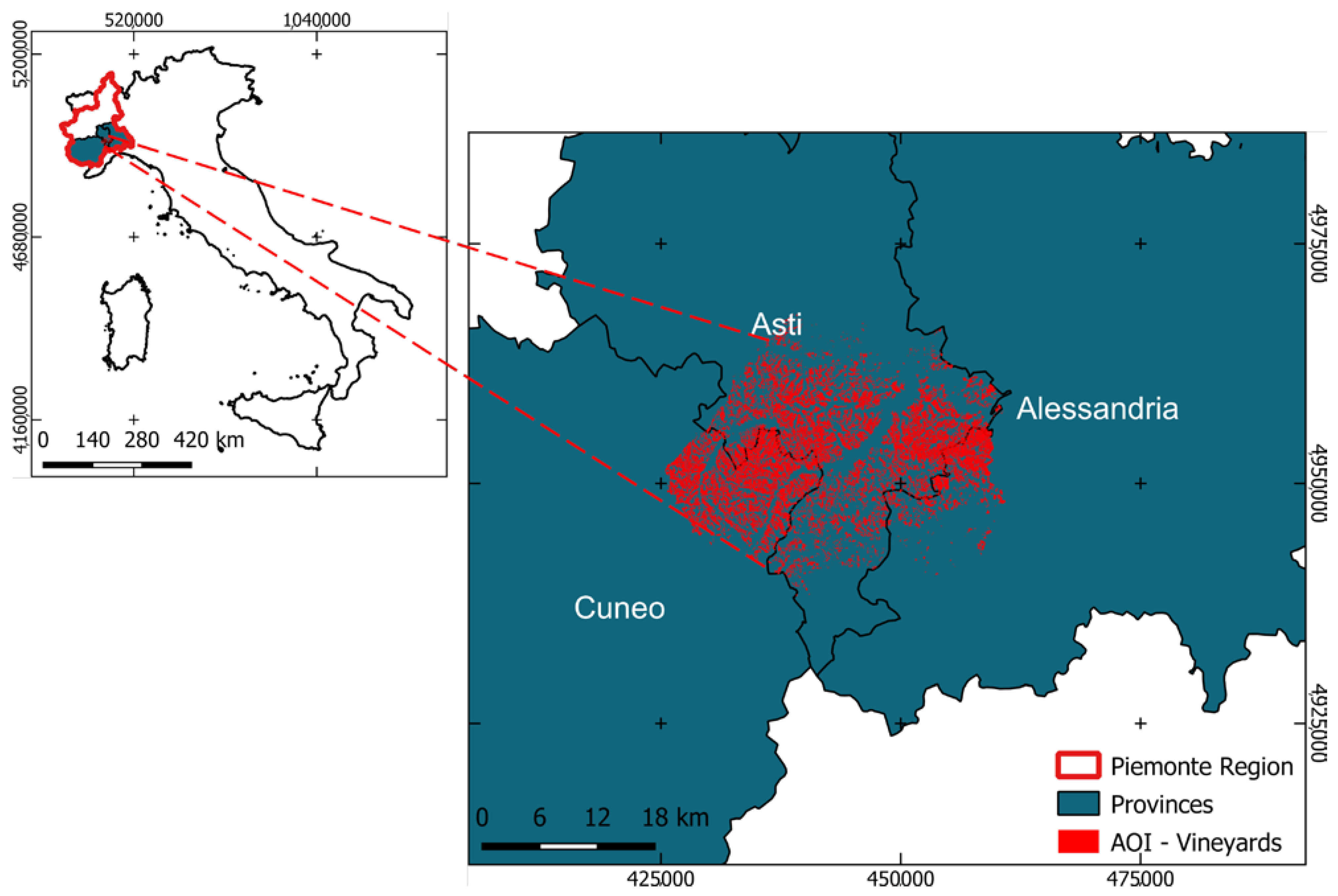
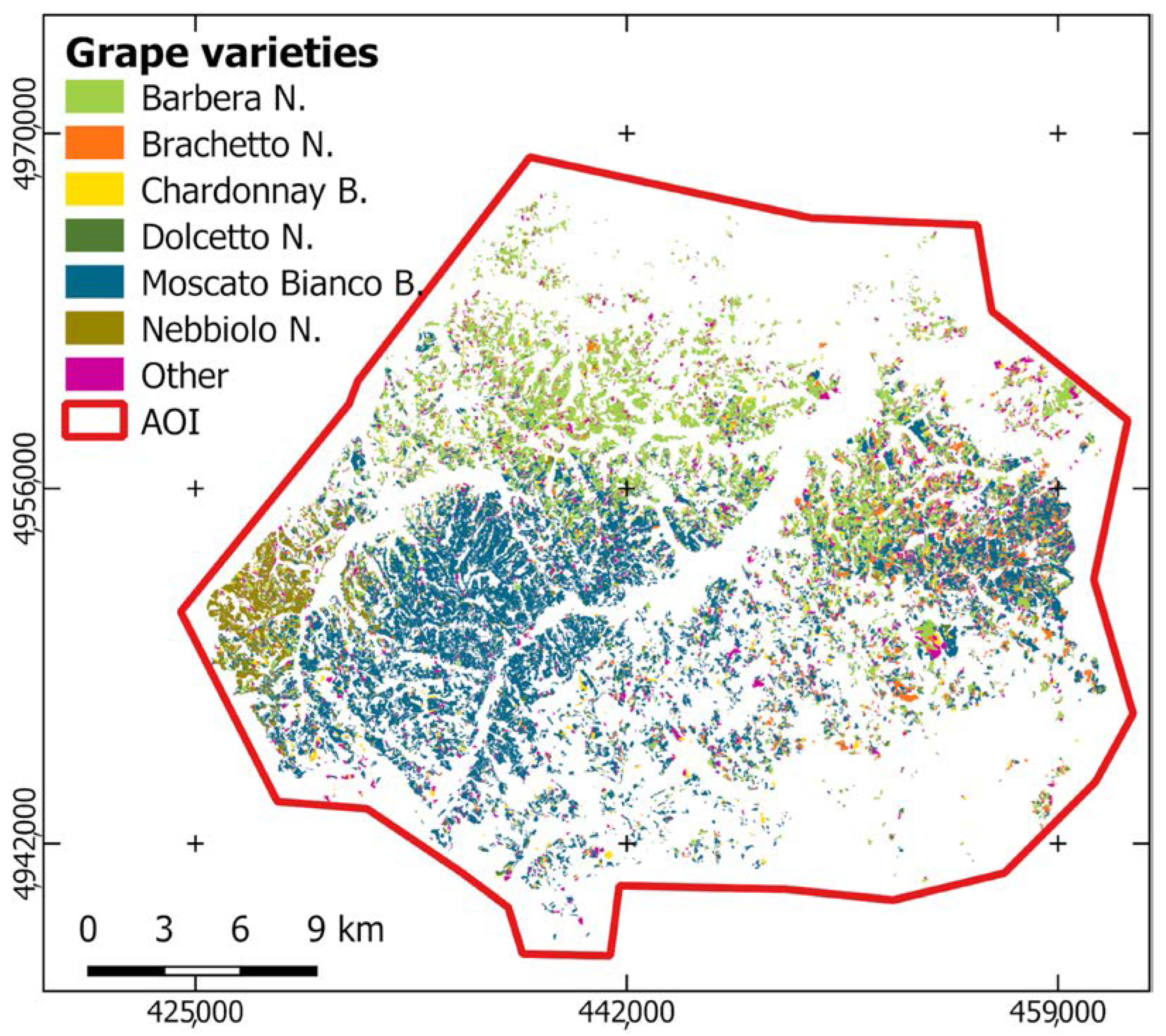

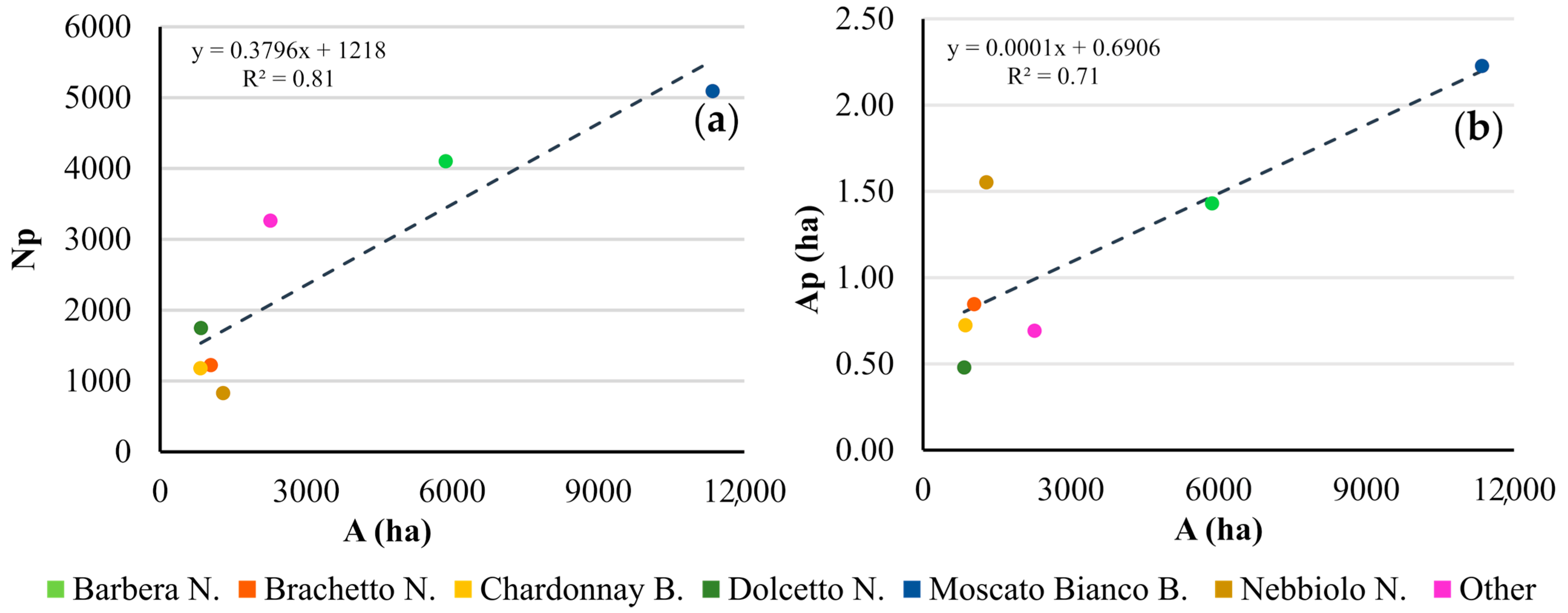


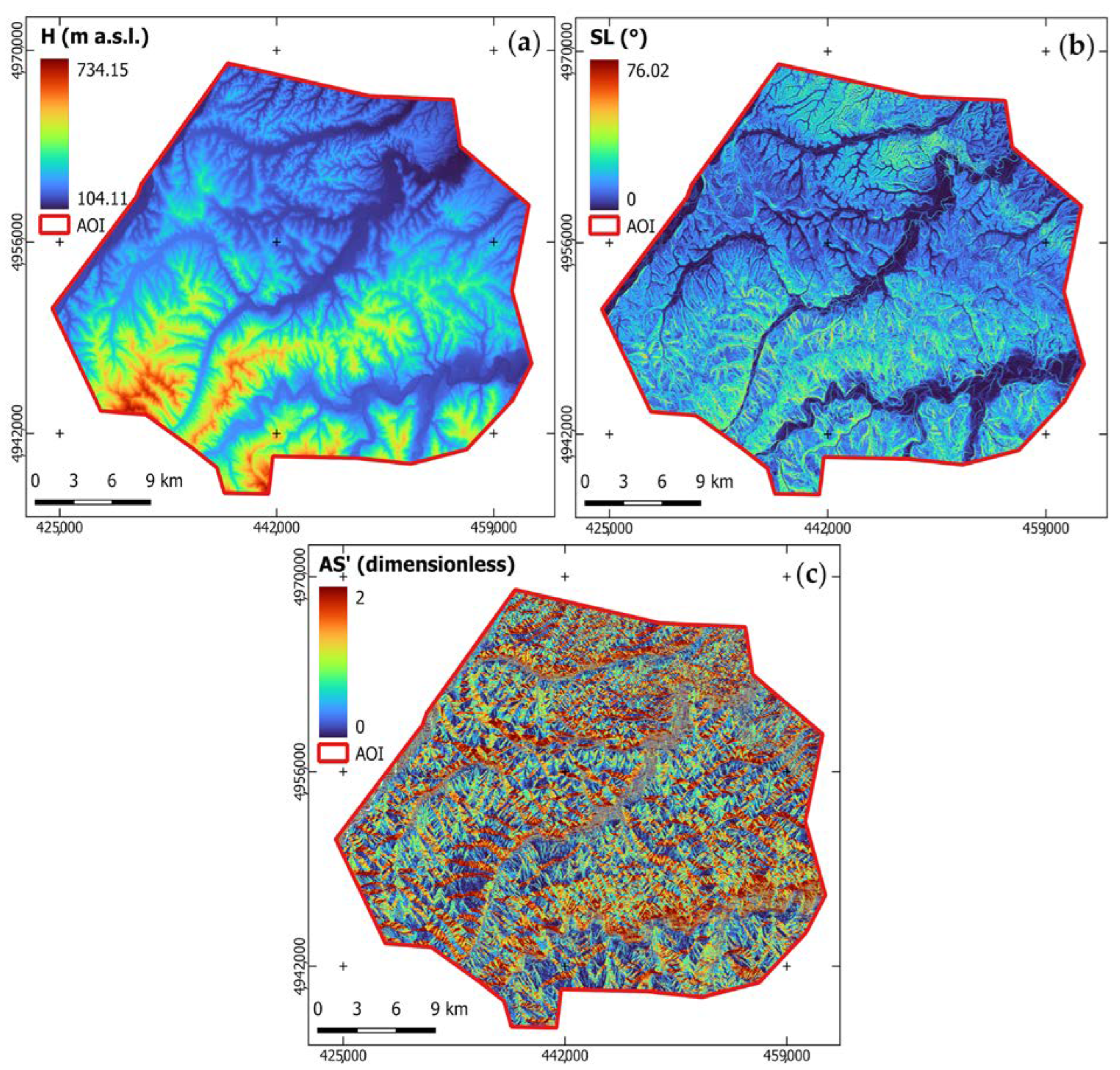
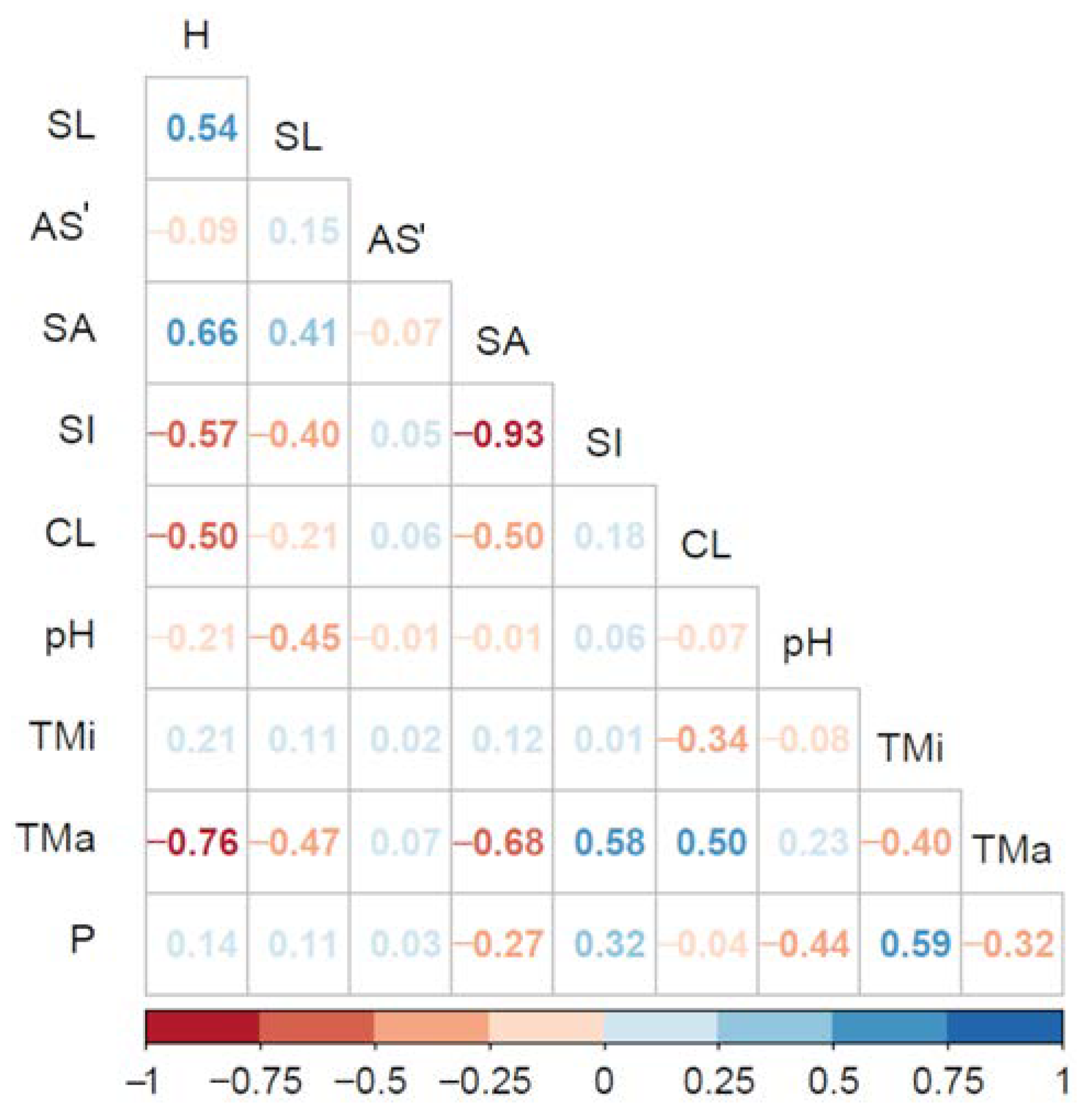
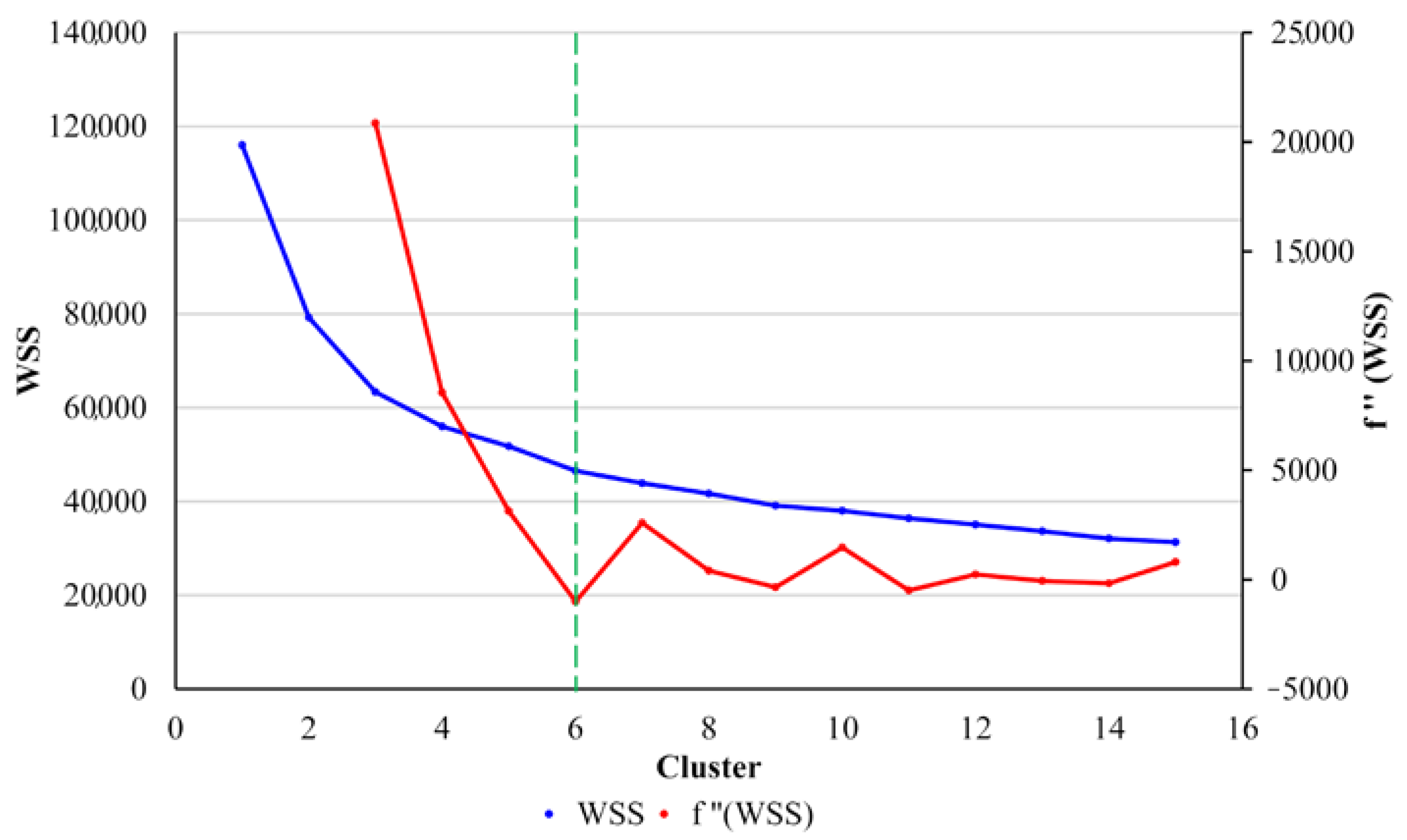
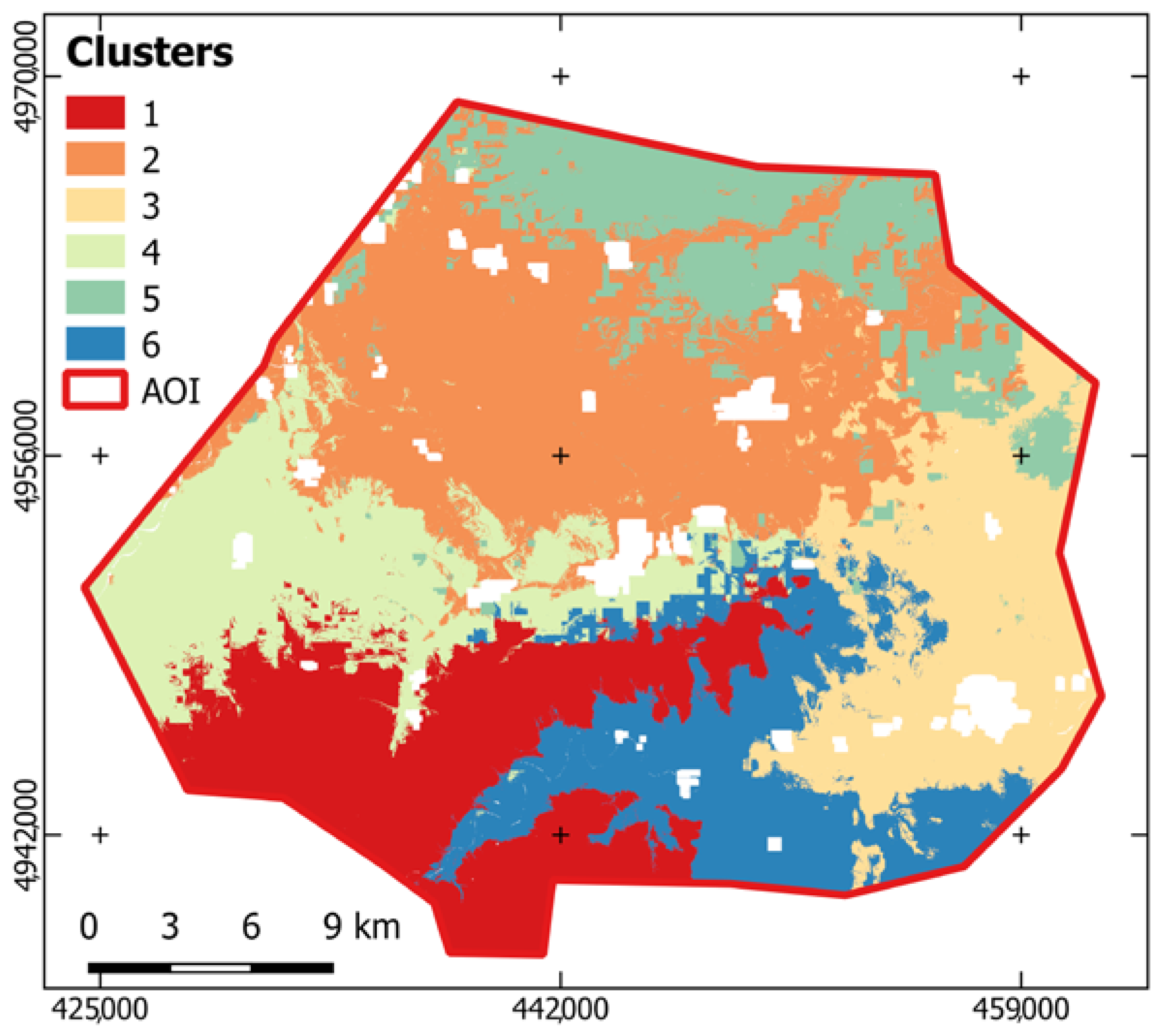

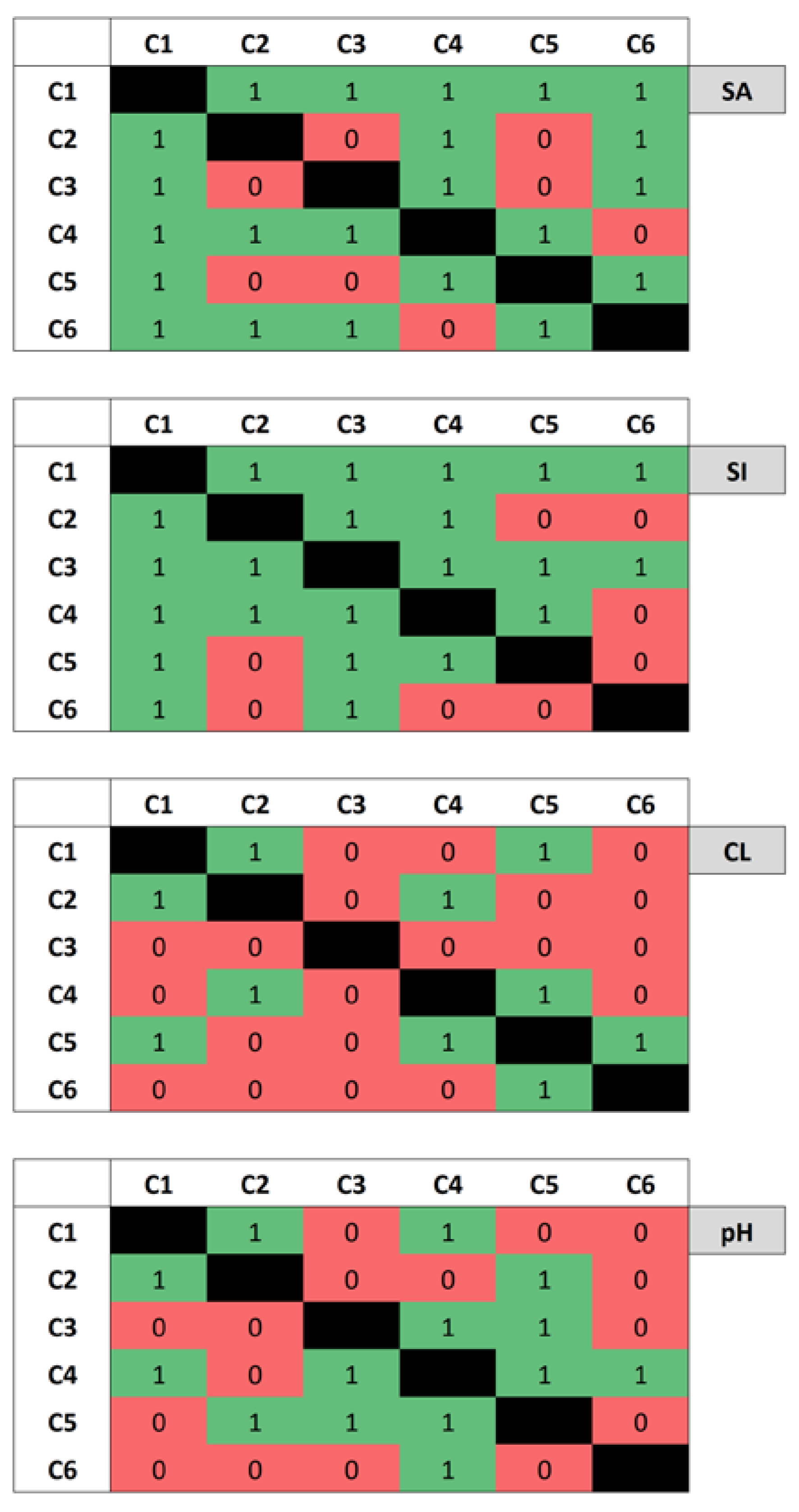

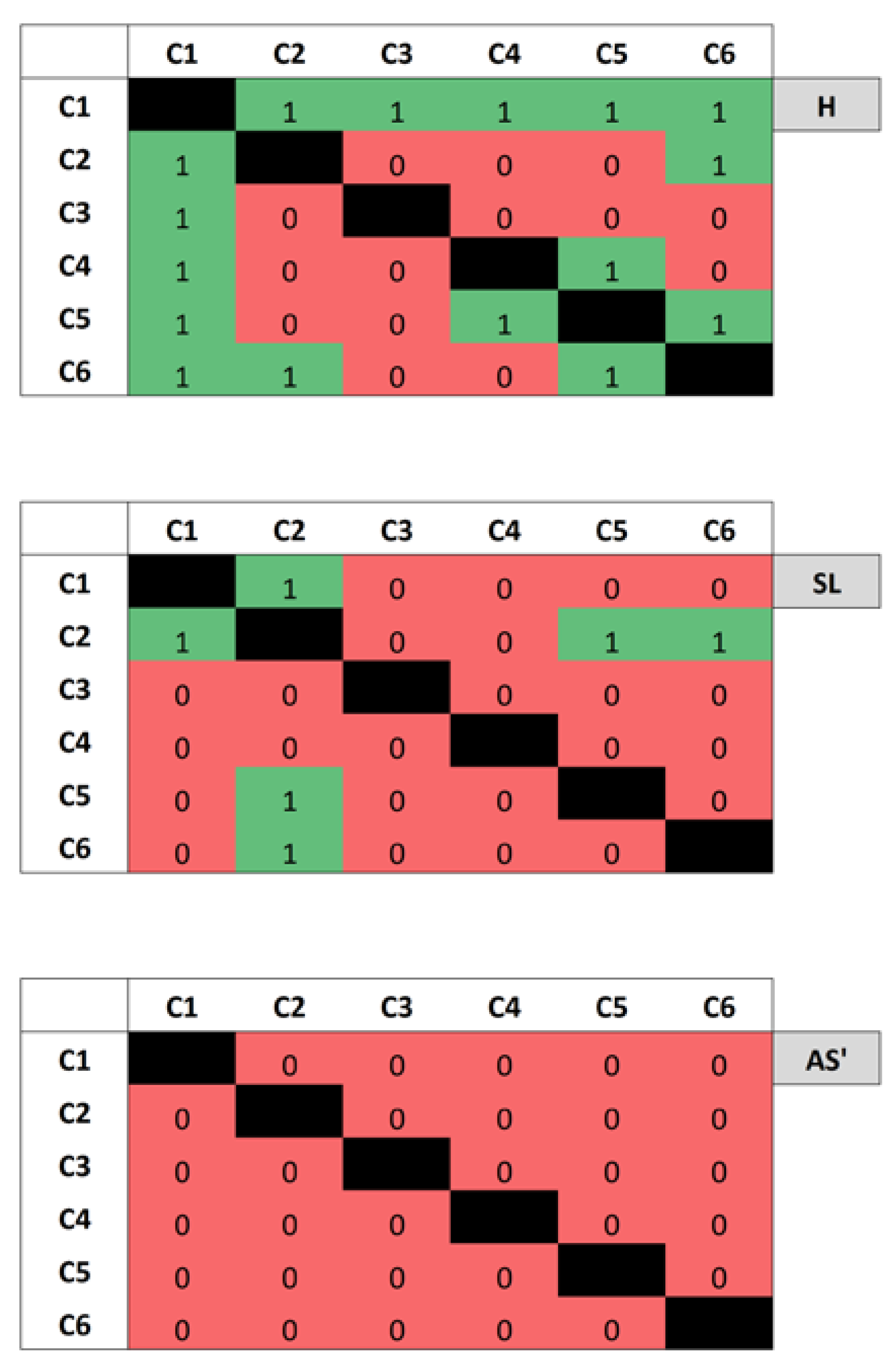
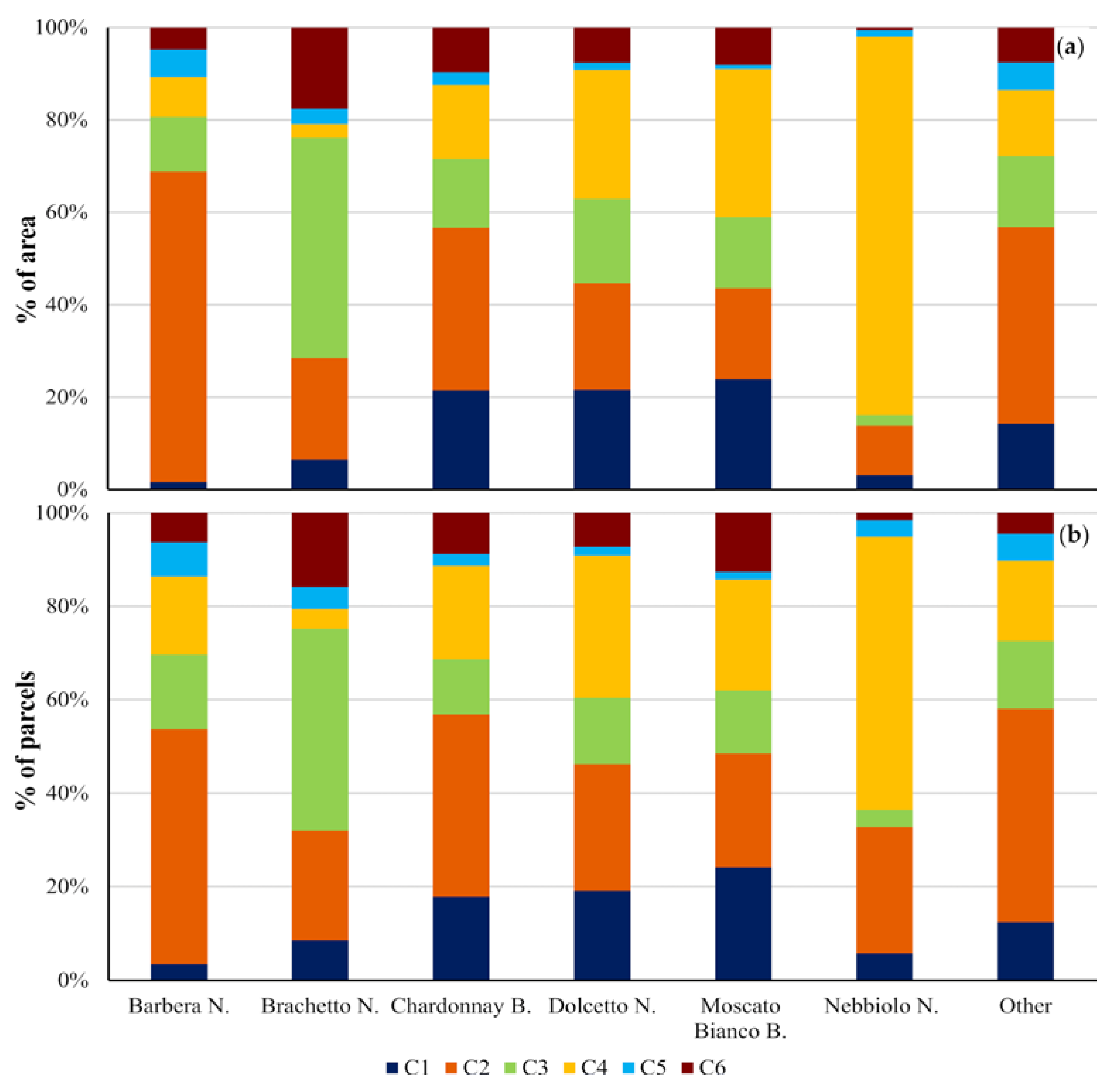
| Parameters | Condition |
|---|---|
| Method | Iterative minimum distance |
| Clusters | 6 |
| Maximum iterations | 1000 |
| Normalise | No |
| Update colors from features | No |
| Start of partition | Keep values |
| Old version | No |
| Cluster (C) | Area (ha) | Area (%) |
|---|---|---|
| C1 | 13,547.88 | 17.20 |
| C2 | 22,339.15 | 28.36 |
| C3 | 11,577.79 | 14.70 |
| C4 | 11,301.25 | 14.35 |
| C5 | 9690.65 | 12.30 |
| C6 | 10,308.72 | 13.09 |
| Cluster (C) | Minimum Temperature— TMi (°C) | Maximum Temperature— TMa (°C) | Cumulative Precipitation— P (mm/year) |
|---|---|---|---|
| C1 | 0.14 ± 0.18 | 28.50 ± 0.39 | 638.89 ± 23.63 |
| C2 | −0.07 ± 0.11 | 29.95 ± 0.15 | 598.28 ± 38.40 |
| C3 | 0.34 ± 0.26 | 29.55 ± 0.25 | 702.53 ± 22.97 |
| C4 | 0.04 ± 0.15 | 29.52 ± 0.40 | 574.95 ± 28.86 |
| C5 | −0.18 ± 0.13 | 29.85 ± 0.14 | 628.48 ± 39.16 |
| C6 | 0.49 ± 0.23 | 29.00 ± 0.29 | 671.73 ± 34.34 |
| Cluster (C) | Altitude—H (m a.s.l.) | Slope—SL (°) | Transformed Aspect—AS′ (Dimensionless) |
|---|---|---|---|
| C1 | 435.87 ± 87.47 | 20.55 ± 8.34 | 0.83 ± 0.69 (NWW/NEE) |
| C2 | 193.30 ± 45.67 | 8.63 ± 5.31 | 0.88 ± 0.69 (NWW/NEE) |
| C3 | 235.22 ± 60.18 | 11.51 ± 7.91 | 0.93 ± 0.70 (NWW/NEE) |
| C4 | 273.80 ± 73.01 | 15.22 ± 8.84 | 0.81 ± 0.66 (NWW/NEE) |
| C5 | 190.01 ± 36.72 | 17.04 ± 6.42 | 0.96 ± 0.70 (NWW/NEE) |
| C6 | 295.07 ± 77.07 | 17.18 ± 6.56 | 0.91 ± 0.68 (NWW/NEE) |
Disclaimer/Publisher’s Note: The statements, opinions and data contained in all publications are solely those of the individual author(s) and contributor(s) and not of MDPI and/or the editor(s). MDPI and/or the editor(s) disclaim responsibility for any injury to people or property resulting from any ideas, methods, instructions or products referred to in the content. |
© 2023 by the authors. Licensee MDPI, Basel, Switzerland. This article is an open access article distributed under the terms and conditions of the Creative Commons Attribution (CC BY) license (https://creativecommons.org/licenses/by/4.0/).
Share and Cite
Ghilardi, F.; Virano, A.; Prandi, M.; Borgogno-Mondino, E. Zonation of a Viticultural Territorial Context in Piemonte (NW Italy) to Support Terroir Identification: The Role of Pedological, Topographical and Climatic Factors. Land 2023, 12, 647. https://doi.org/10.3390/land12030647
Ghilardi F, Virano A, Prandi M, Borgogno-Mondino E. Zonation of a Viticultural Territorial Context in Piemonte (NW Italy) to Support Terroir Identification: The Role of Pedological, Topographical and Climatic Factors. Land. 2023; 12(3):647. https://doi.org/10.3390/land12030647
Chicago/Turabian StyleGhilardi, Federica, Andrea Virano, Marco Prandi, and Enrico Borgogno-Mondino. 2023. "Zonation of a Viticultural Territorial Context in Piemonte (NW Italy) to Support Terroir Identification: The Role of Pedological, Topographical and Climatic Factors" Land 12, no. 3: 647. https://doi.org/10.3390/land12030647
APA StyleGhilardi, F., Virano, A., Prandi, M., & Borgogno-Mondino, E. (2023). Zonation of a Viticultural Territorial Context in Piemonte (NW Italy) to Support Terroir Identification: The Role of Pedological, Topographical and Climatic Factors. Land, 12(3), 647. https://doi.org/10.3390/land12030647








